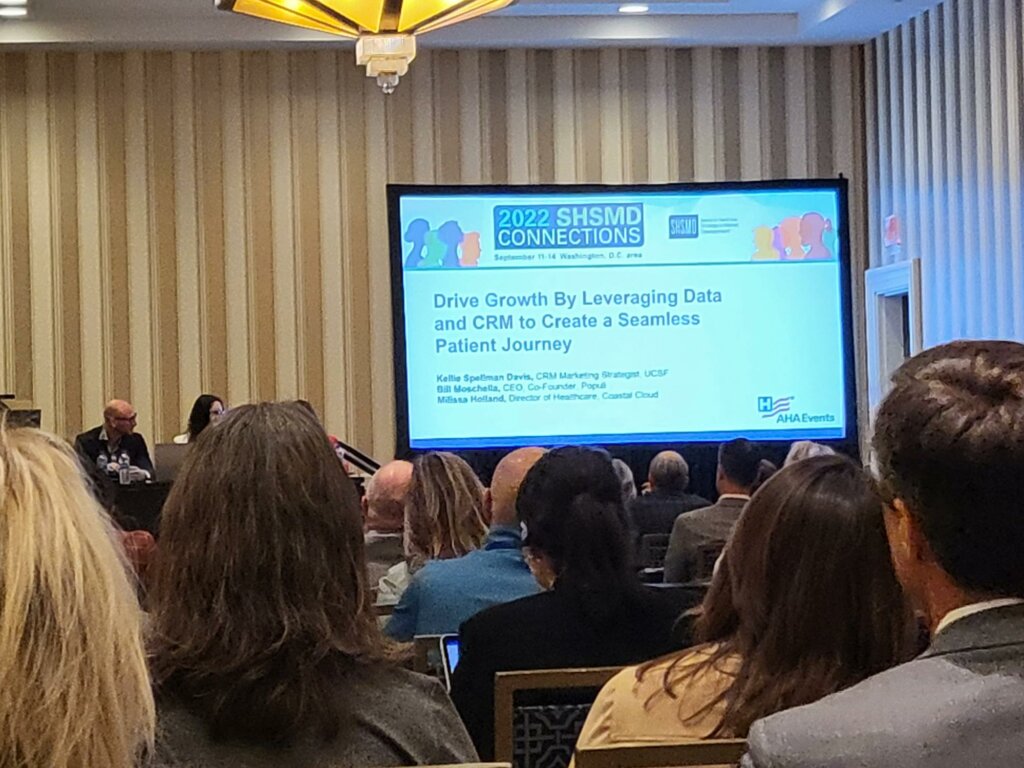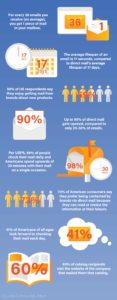Key Takeaways from SHSMD Connections 2022
Back at it Again!
It was great to see everyone at SHSMD 2022 in National Harbor, MD! With our new, brightly lit and eye-catching booth backdrop, we were able to meet new contacts – as well as catch up with current clients! The light and inviting atmosphere of our booth made it a great space to discuss marketing goals and showcase some of what we do here at Strata.
With SHSMD 2022 wrapped up, we’re excited to see how our connections grow, and how we can continue to help healthcare marketers and others with offerings beyond just new mover marketing. Whether it’s patient acquisition, talent acquisition, or promoting your service lines – we’re here to take your marketing to the next level. With that said, here are a few of our key takeaways in case you missed the show or didn’t get to stop by our booth this year.

The Conference in Review
At the beginning of the show, the team first joined other SHSMD attendees at Monday morning’s keynote — delivered by Suneel Gupta, a bestselling author, host of an American Express docuseries and podcast, and Visiting Scholar at Harvard Medical School. He spoke on the importance of long-term successes coming from short-term embarrassment, and explained that by gathering people who will challenge, encourage, work alongside and coach you, you’re becoming “backable.” He also emphasized that putting yourself out there only helps you get better at what you do – and that it’s important to be “backed” by the team you’ve assembled.

From there, the team moved to breakout rooms to learn a bit more about the needs and challenges that healthcare marketers currently face. We attended sessions surrounding digital and AI learning, nursing acquisition and retention, media buying innovations, and more.
A big topic was the idea that – as we’re continuing to traverse the digital age, it’s important that healthcare providers meet their potential patients and talent where they are. Whether someone is looking for an urgent care center, a primary care provider, or employment, the goal is to remain end-user focused. When marketing healthcare services to people in your area, it’s vital (no pun intended) to utilize demographic and psychographic data for the targeted population that your healthcare center serves. Because of this idea and the rise of ethical marketing, we’re seeing just how tactful marketing campaigns – both print and digital – need to be in order to be successful and worthwhile. Strata is well versed in this notion, and the atmosphere and chatter at SHSMD 2022 simply reiterated and expanded upon what we know to be true. Whether you need marketing that will facilitate patient acquisition, talent acquisition, or service line promotion, we’re here to make smart happen. We can help streamline your marketing to reach the talent you need and the customers you want. Right where they are.


Some Final Thoughts
Last but not least – the conference reinforced the importance of good design to reach and engage your target audience! We’re glad that, here at Strata, personalized, eye-catching campaigns are right up our alley – and we have the experience and design talent to make them happen. Using demographic and psychographic data, as well as eye-catching imagery and layout, we create compelling pieces of print, direct and digital mail that follow branding specific to our clients and incorporate unique touches that help your system stand out among competitors.

Didn’t get to discuss your healthcare needs with us at SHSMD 2022? No worries. We’re happy to have a quick chat or set up a call. Contact us today!
Untrue & Debunked
With years of experience, we’d say we’re experts in direct mail marketing. But we’re not just the mail people. We provide highly impactful direct mail marketing that cuts through today’s digital noise to deliver a tactile experience and leave a lasting impression. That’s why we’re well versed in all of the misconceptions about direct mail floating around out there, and can tell you exactly why they’re untrue. Follow along as we debunk the 6 misconceptions of direct mail.
Misconception 1: Direct mail is past its heyday
Once in a while, we hear people speculate and assume that direct mail is past its peak – but just because direct mail has stood the test of time, doesn’t make it outdated. It’s been around for a while for a reason, and has evolved and changed over time – with the times. In fact, in a recent IAB survey, six out of ten marketers prefer direct mail over other offline channels and still include it in their direct marketing strategy today.
These days, direct mail breaks through the digital noise and is unique and different than other marketing tactics. It brings about nostalgia, as people enjoy the feeling of paper in their hands, similar to enjoying paperback books over kindles. Plus, for every 36 emails you receive (on average), you get 1 piece of mail in your mailbox. The possibilities are quite endless, with many exciting design opportunities and options. Really, direct mail is only boring and old if you make it that way.
Misconception 2: Compared to other tactics, direct mail doesn’t provide ROI
This one couldn’t be further from the truth. Don’t believe us? Here are just a few stats to back us up. The average lifespan of an email is 17 seconds, compared to direct mail’s average lifespan of 17 days. Up to 90% of direct mail gets opened, compared to only 20-30% of emails. Per USPS, 98% of people check their mail daily and Americans spend upwards of 30 minutes with their mail on a single occasion. Direct mail open rates can reach up to 42%. Recipients of direct mail also “purchase 28% more items and spend 28% more money than people who don’t get that same piece of direct mail.” Direct mail gets response rates 10 to 30 times higher than digital channels, according to the DMA (Direct Marketing Association).
Basically, direct mail usually does very well in terms of ROI, and it can (and should) be tracked – so make sure you’re getting the most out of it by making it trackable with the use of digital touchpoints.
Misconception 3: Direct mail marketing is expensive
When people think of print, they sometimes think of high-cost, but that’s not always the case. If you have a quality list and are getting the most out of each mailer you send, direct mail won’t seem all that expensive. What do we mean by a quality list? If you’re sending to strategic, particular contacts – not just any contacts, your ROI will be worth the price.
Additionally, print often gives you more for your money while other marketing practices alone may not (for example PPC, social media ads, email marketing platforms, and more). According to the stats, mail marketing is much more likely to be seen and paid attention to.
Misconception 4: Millennials and younger don’t like or pay attention to direct mail
Direct mail isn’t just effective for older audiences. Actually, 73% of American consumers (in general) say they prefer being contacted by brands via direct mail because they can read or review the information at their leisure. And, 41% of Americans of all ages look forward to checking their mail each day.
Millennials, specifically, like to feel important and seen, so the personalization opportunities of direct mail make for great millennial marketing. To add to this, many millennials and Gen-Z-ers have digital fatigue and find taking a “break” with print to be often enjoyable, and it “should be no surprise that those raised on the internet are best able to tune out online ads.” They also have shown to have a lot more trust in print resources than in digital.
Misconception 5: Direct mail works on its own and doesn’t integrate with other channels
These days, direct mail is actually an excellent touchpoint among many, especially when conducting a multichannel marketing campaign. And, we’d even say that combining tactics, even if it’s just two, is usually the way to go. In a recent study, a whapping 68% of marketing respondents saw that combining digital and direct mail increased visits to their websites.
So, how do you integrate physical with digital? By using a URL of a landing page or website, a PURL (personalized URL), BRC (business reply card), or a QR code. Any of these can be used to lead the viewer to a digital touchpoint. These can all also be used to measure attribution and better understand your target audience, and the emails and other information acquired from BRCs or online landing page forms can be used for email marketing, targeting customers with digital advertising, and sending further communication.
Misconception 6: Direct Mail = Junk Mail
Unlike junk mail, direct mail is focused, targeted, relevant, ROI-producing, and uses a quality send list. For more on why direct mail isn’t the same as junk mail, check out our blog, “Direct Mail vs. Junk Mail”, here. Strata can be a resource for direct mail with a surgically targeted list of prospects that are not only more likely to have a need for your project or service, but are also more likely to respond.
Now that it’s a bit clearer that direct mail is relevant, effective, and can be a huge part of the bigger picture of a marketing strategy, you may be interested in giving direct mail marketing or multichannel marketing a try. If so, give us a call.
What Makes Data Good Data
We always, always appreciate conversations with customers. Especially those that make us think more thoroughly about our services. We’re constantly open to changing and evolving to provide the best offerings possible for loyal and new customers alike. Recently, we’ve had quite a few conversations about data, and have realized that it’s important for us to provide some insight into our somewhat unique data philosophy, specifically as it relates to direct mail. We’re all about the best data – not always (and not usually) the most data.
Our Direct Mail Data Philosophy
Direct mail may not be the cheapest form of marketing – but it’s often one of the most effective. In fact, 61% of customers find direct mail influential in making purchasing decisions. Compared to email’s average lifespan of 17 seconds, direct mail can last 17 days. We could go on and on about why we love direct mail, which is why we made a complete blog with tons of other eye-popping stats.
While direct mail is very effective – it’s only as effective as the data behind it. We believe it’s important to reach the right people, which is not usually all the people, and this can sometimes be puzzling to our customers. Our philosophy? We’re more worried about and interested in the success of your campaign rather than the number of people we send to. Plus, while we appreciate business income, we more highly value long-lasting business relationships built on trust (which primarily comes from a good track-record). In short – quality over quantity, always.
When we pull our data, you’ll notice that compared to others in the industry, we don’t always end up providing as many contacts. This may look and seem like “less”, but it’s really providing you with “more”. We won’t give you more contacts than necessary, we won’t waste your time with leads that are dead on arrival, we won’t waste your money on mail that ends up in the trash, and we will deliver higher ROI. Many others in the industry will provide you with a bigger list, but one with a portion of people who will trash your direct mail – wasting your time and budget. So, next time you see a long list of “prospects”, don’t let it knock your socks off before diving into who those people really are, what they want, and whether or not they’ll actually respond to you, and, more importantly – become a customer.
Why Our Data is Strong
Strata has years of experience as well as many great connections within the industry. Our data compilation process is rigorous, and one that we’ve worked on for years to define and strengthen. To ensure it’s effective and valuable, we continually evaluate our data sources time and again, never assuming they’re “good as they are”. And similar to how open we are to customer feedback, innovation, and change, we’re always open to changing and improving our data sources so that data we provide, again, will actually return ROI.
Interested in working with Strata to get the most out of good data? Contact us.
Why They’re Not (at All) the Same
Sometimes direct mail gets a bad rep. Why? Because it’s commonly mistaken for junk mail. But other than being mail, these two have nothing in common. Direct mail only falls into the category of junk mail when it’s poorly executed. When done right, direct mail targets, entices, and benefits a specific customer. Someone, who through market research, is most likely in need of your product or service. It’s designed with purpose in mind, is backed by research and data, drives audiences with calls-to-action, and is highly customized and personalized. Take a quick read to further understand how direct mail differs from junk – and why it should be a key part of your company’s marketing strategy.
Direct Mail Starts with a Good List
The biggest difference between direct mail and junk mail is a good list. A list that’s backed by data, and one that targets the right people – not just any people. Before making an effective, comprehensive or specified list, first review the mailing lists you currently have. Who are you sending mail to? Who have you sent to in the past? Are they the right audience(s)? Are there more audiences (or more specific audiences) you should be targeting?
A wrong list will fail to target those who’d be interested in buying from you, and will often also target those who’d have no interest at all (cough, cough – junk mail). For example, sending “get 10% off your first order with us” to a loyal customer, or even worse, trying to sell meat to a vegetarian. Junk mail goes to anyone and everyone, and often with irrelevant and impersonal information. Plus, it’s often a waste of money, as many of those unspecified and uninterested customers will throw your mail out without a second thought.
In contrast, direct mail is sent to people in data-driven lists, and with messaging that makes sense for their specific customer profiles. Compiling this strategic list makes all the difference in targeting the right customers and catching their attention. Direct mail, unlike junk, is sent to direct people for direct reasons. In fact, 42% of recipients read or scan direct mail that’s relevant to them.
Types of Direct Mail Lists
Direct mail lists come in many forms, so it’s good to take a look at them all before deciding what will work for your company and its marketing needs. Here are the 4 most common ones:
House List: A list you’ve collected on your own time of prospects and customers you’ve made connections with. People on this list are likely to respond, because they’ve already responded to previous offerings.
Response List: A list you’ve put together of people who’ve responded to and reacted to your outreach before. Whether they’ve purchased something or have asked for more information, these people have some level of interest in your offerings.
Compiled List: A list of candidates that went through screener questions and possessed a characteristic or set of characteristics you searched for. These characteristics are fixed, and are most commonly age, gender, location, or income level.Another characteristic could be new movers – those who just moved in and are looking to become loyal customers of your services.
Segmented List: A list curated through a high-tech analysis platform that defines key prospects. This type of list accesses information far beyond age, income, and gender, and gives you the ability to micro-target your market for more extreme results and higher ROI. This type of targeted list also helps you avoid sending to “do-not-mail” contacts.
Direct Mail Has Personally Relevant Messaging
After you decide on a list, the next step is deciding on the right messaging. Direct mail isn’t just about knowing who to send to, but how to speak to them to get them to notice, develop interest, and potentially buy from you. Look into your customers’ buying habits. What entices them? What offerings are they most interested in? And, how can you best reach them? Knowing the proper way to connect with your current and potential customers will help your mailer stand out. Don’t just use a cheesy, typical slogan or generic text. Craft words that highlight who you are, what makes you unique, and why they should use your surfaces or buy your offerings (over others). Make your mailer personal by adding their name, incorporating content that makes sense to their age and other demographics, and including offers applicable to them. Lastly, a clear call-to-action can educate the recipient in how to respond in the most efficient and convenient way possible.
Direct Mail Has Purposeful & Impactful Design
Lastly, once you’ve crafted effective messaging, design your mailer with intentional and engaging visuals. Make sure you’re thinking through the following key design aspects:
Sizing: Think about what size mailer makes sense for your audience, and what will help yours stand out in the mailbox among others. And, in terms of font size – think over what message is most important to get across. Use sizing hierarchy to emphasize words like “free” or “grand opening”.
Layout: Always consider how you want the viewer’s eye to be lead across your mailer. One good technique is the “s-curve” layout – which leads the eye down and across by using imagery on the left and words on right, or a similar variation.
Graphics: Using unique and eye-catching graphics is a great way to make your business stand out from the rest. Be sure to use high quality images as well as consistent branding elements – such as a logo, fonts, colors, and textures. And, go further by using variable images depending on who’s receiving the mailer to make it resonate with the viewer.
Color: Pops of color are also a great way to spice things up – especially when they’re not expected, or to emphasize a call to action. For example, use pops of color on new services, departments, or special offers, or to emphasize a QR code.
Altogether, the key to good mailer design it to ensure it resonates with the customer and emphasizes who you are and the message you’re trying to send. For more help with mailer design, specifically, check out our blog on current direct mail trends.
Now that we’ve gone through what makes direct mail, well, direct – we hope you can see that it is drastically different than unsolicited junk mail. If you’re looking to make a change with your direct mailers or simply want to learn more, contact Strata’s experts.
To Keep an Eye on
As a marketing solutions company with lots of interest in innovation and change – we’re big on knowing what’s trending and what’s to come. 2021 was filled with a ton of new trends, some – because of changing times and innovation – others, because of big events and worldly occurrences. To stay ahead and prepare for the new year, we’ve looked into the top marketing trends – within design, print, and digital, to keep an eye out for in 2022.
2022 Design Trends
Visual Inclusion
Recent movements around the nation, and even the world, have sparked a broader portrayal of diversity and inclusion in visuals. When crafting your marketing, think about how you can show diverse people in a variety of ways – in your photography, graphics, and iconography. And, even more, think about including imagery of people that your target audience(s) can relate to.“The default for people icons and images are no longer white, male, and able-bodied. There is more representation from marginalized groups in marketing visuals.” The more open, inclusive, and inviting your marketing is, the more likely you’ll bring in a diverse range of interested (and trusting) customers.
Bold Backgrounds
Bold and bright backgrounds and backgrounds with patterns are on the rise. These types of backgrounds attract attention and stand out from the pack, among otherwise modern – and primarily dull, gray, or white – busy feeds and mailboxes. Try using a brighter, bolder background to stand out among other marketing materials. This tactic can be “quite stunning when paired with more simple typography or other design elements,”but, to make this trend work for you and your brand, “ensure that everything has a place and there’s good eye flow between elements.”
Unique & Fun Typography
The year 2022 will be all about typography that “breaks standards”, such as “one single letter…upside down, bigger or smaller, in a different font, or completely missing.” Forecasters expect “lettering that pushes the bounds of easy legibility, creating forms that are expressive in and of themselves.” This unique and rising design tactic can also make for more internationally understandable text and imagery that can be read from culture to culture.
Authentic Imagery
Authentic, realistic imagery that your audience can connect with is always important – but will be increasingly popular in 2022. People don’t want to see fake stock families and disingenuous product photos. They want to see real. “Even commercial photography is shifting to look more like snapshots for these projects” instead of planned, posed imagery. This tactic may be a little less polished and intentional, but it works, because it’s relatable. “More authentic imagery is not amateurish; it’s just a different style.” Yet, this doesn’t mean taking blurry or “thrown together” photos. It means shooting high-quality photography that’s just a bit more casual and realistic to real, day-to-day life.
2022 Digital Marketing Trends
Conversational Marketing
This will be a big one for 2022, as it’s already been on the rise for quite a few years. Why? People want to connect with, and relate to, real people. And, they want fairly immediate responses from those real people. Customers feel more connected with and trusting of companies that tell their story, as well as the stories of their products. They want to hear and see real life examples of what the product has and does, and what sets it apart.
A recent study found that 41.3% of consumers use conversational marketing tools before making purchases. “Unlike traditional strategies, this form of marketing is now available across multiple channels, allowing brands to meet customers on their terms: on the devices, platforms and time schedules that suit the customer best.”
Read more about customer communication and relatability, here.
Video Marketing
This trend isn’t new, and is likely to continue in popularity for the next 5-10 years. It’s no surprise to us (and likely not a surprise to you) that 61% of marketers see video as a “very important or extremely important” part of their marketing strategy. It’s a useful tactic not only because of its visual appeal and high rate of easily digestible content, but because it can be republished on several platforms, and cut and manipulated for repurposing. A recent study recorded that “84% of consumers have been convinced to purchase a product after watching a video.”
To read more on video marketing, click here.
Interactive Content
This year, there will be a noticeable marketing shift from “traditional text-based content toward dynamic, engaging content” like quizzes, augmented reality, polls, 360-degree videos, and more. These tools give customers a more memorable connection with both the product and the company, and get them involved with the brand – not just get them to see it. In fact, 91% of customers are interested in seeing more content they can interact with.
First-Party and Zero-Party Data
We’ve talked a bit about this topic before in a fairly recent blog post, and this trend is sure to skyrocket into 2022. This year, “first-party cookies will force marketers to be mindful of the data they collect and how they use it,” primarily because companies can now only use their own collected data. This also means that companies will need to be much more authentic and transparent with their customers. Along with first-party data, zero-party data – data given to a brand or company directly from the consumer, will also be a key focus. Some examples of ways to acquire this data are through surveys, forms, or email.
2022 Print Marketing Trends
Combining Print & Digital
This particular trend – we’re very well-versed in. Combining print and digital can do wonders for your campaigns, meeting your customers with mulitple touches on and offline. A great example of this combination is using a personalized URL and QR code on a printed piece. QR codes on print marketing not only give customers an easy way to get to know your company better, but can be vehicles to get customers to purchase or sign up for a program – immediately. These types of combination tactics are flexible, dynamic, and cater to many differing age groups.
Creative Customer Personalization
Also, a great online or offline tool? Personalization. When your company caters to a specific type of audience, or even specific customers rather than a blanketed group, you’re more likely to meet customer’s needs and turn them into loyal ones. Additionally, personalization can be cost effective. Why’s this? In order to personalize, you can’t target everyone – just the right ones.
Direct Mail
Lastly, not a new or surprising trend to us, direct mail will continue to grow in popularity in 2022. “With the content marketing boom and remote working becoming the new normal, many consumers have become ‘numb’ to digital marketing campaigns.” So, if you haven’t, why not give direct mail marketing a go? Trying out this re-emerging marketing trend could bring a ton of new customers to your site, as 70% of people engage with a brand online after receiving their direct mail.
Read more on why direct mail is so impactful, here.
Interested in ramping up your marketing in 2022 using one or more of these solutions? We can help! Contact the experts at Strata, today.
With a Combination of Direct & Digital Marketing (and the Right Partner)
Maybe you’ve heard about the paper shortage, or maybe you’ve experienced it first-hand. Either way, it’s something you should know about, as it’s seemingly becoming a bigger issue in our field day by day. But, before we sound all doom and gloom, we do have good news. Although it’s a current issue we’re facing, there are ways to combat it and work around it. In this blog, we’ll walk you through what exactly is causing the shortage, what it means for us (and you), and how we all can continue business as (almost) usual.
What’s Happening with the Paper Shortage?
So, what’s really going on? Well, there are many shortages going on right now – primarily due to all of the craziness that’s ensued over the past few years. The pandemic has been the primary factor in most shortages, from toilet paper to manufacturing products, and everything in between. Something else that’s suffering? Lumber, and in turn – you guessed it – paper.
Back in 2020, the demand for paper dropped by “up to 75% in some segments” due to drops in education and office space usage. Because of this, “paper mills reduced or curtailed production…which caused inventory to drop to levels which have not been seen previously.”
More recently, there’s been a “convergence of Canadian lumber tariffs, increase in demand for home remodeling and building of homes brought on by the pandemic, and hiccups in supply related to transportation.” From home projects to home purchases, we’re now using a lot of wood. More wood demand has called for changes in processes for these previously idle lumber suppliers, which has slowed production – and even worse, transporters impacted by Covid-19 risks has made for fewer available drivers to carry out shipments from mills and shipping ports.
Generally, one thing has led to another, causing a domino effect that’s triggered lumber prices to skyrocket, and has disrupted several industries.
What Does This Mean for Marketers & Print Projects
Yes, the paper shortage is concerning, but it doesn’t make print and direct mail marketing impossible or any less effective. With that said, don’t go overboard. Be aware of the materials you’re using and try to keep a close eye on the balance of supply and demand. While the lack of resources is a hurdle, the shortages are actually giving printers and marketers an opportunity to get creative with project execution by combining print with digital and trying new outreach possibilities.
How Can We Combat the Shortage?
There are several ways to work around the current hurdles we’re facing. The first? Using more digital technology wherever possible (and effective) – like QR codes, for example – to cut back on the paper needed to communicate a message or tell a story. Not only can QR codes and PURLs, or other tools help you use less paper, but they can help you more effectively track, monitor, and enhance your campaign. You can also try supplementing your multiple direct mail touches with other tools like digital ads and emails. A multichannel approach is always more impactful than a single channel, anyway.
Next, look into making your mailers, flyers, and other print marketing materials more cost effective by using a smaller paper weight, or stand out in the mail with a smaller but more uniquely shaped piece.
Lastly, look to work with a company with paper buying power and ample experience. They’ll be aware of the current issues, and will understand what’s best for your company’s marketing needs.
Reach Out
When it comes to shortages of any kind, remember to be patient and plan ahead. The paper shortage most likely won’t be around forever, but the more flexible you can be, the more you can mitigate the issue. After reading this, we hope you’re feeling a bit more knowledgeable of the current shortage as well as what you can do to combat it. If you’re interested in learning more about how Strata’s working through the shortage with our client (and on our personal projects), or are looking to work with us on your next multichannel marketing campaign, feel free to reach out.
Not Our First Rodeo
Even though this wasn’t our first rodeo, SHSMD Connections 2021 didn’t disappoint. We had great conversations with so many show-goers, and we got to do one of our favorite things – talk new mover marketing.
In previous years, SHSMD Connections has brought quite the large crowd. Yet, with the needed precautions due to COVID-19, this year’s show created a much smaller, more intimate setting. Although we weren’t sure how the event would pan out, the smaller turnout gave Strata the chance to really chat with others in the industry, and learn more about the needs and wants of healthcare marketers.
About the Show & Our Experience
This year, two of our employees attended the conference in San Antonio, Texas from September 19-21. With Strata’s booth being front and center as guests entered the exhibit hall, our exposure was unmatched, giving us many great moments for conversation. Our bright orange and yellow (recently refreshed) colors kept the atmosphere light and fun, making it easy for the team to meet as many new contacts as possible while also connecting with familiar faces.


We’re really looking forward to seeing, post-show, how these connections flourish and how we can help healthcare marketers and others within the industry with their new mover marketing endeavors.
Our Takeaways
Our presentation of SmartMove and all that we offer was a huge success, and the feedback we were given emphasized the significant need for our services. Healthcare facilities aren’t just looking for direct marketing, but direct marketing that will make an impact and target the right people at the right time. Whether attendees were familiar with new mover marketing or not, our team educated them on Strata’s personalized touch and efficient processes.
But, not only did Strata come prepared to share our services – but prepared and excited to learn! On their breaks, the Strata team attended numerous breakout sessions and learned about everything from inclusion and diversity in the workplace, to problem solving, engagement, and leadership strategies. They even had the chance to hear from Burl Stamp, President and Founder of Stamp & Chase, who discussed how to properly and effectively engage with and lead teams, customers, and communities (especially post pandemic).


Another great session that the team partook in was Derreck Kayongo’s keynote. Derreck presented on the topic of company culture and how to tackle the subject of company diversity head on, by sharing stories of his own childhood to his own organization, the Global Soap Project. Derreck did a phenomenal job guiding the audience through diversity and inclusion problems, and how they impact the corporate bottom line. He left the crowd speechless. The team was incredibly grateful to have attended and listened in on such impactful conversations, and are so excited to not only come back with some new connections, but with takeaways to strengthen Strata’s services and culture.
Our Final Thoughts
Overall, SHSMD 2021 was a success for Strata. While it may not have looked like conferences of years past, we’re glad our team had great conversations and made solid connections with those that could attend. Not to mention, our promo items were a hit! See you next year, SHSMD!
Didn’t get to swing by and meet us at the show? Contact us today to see how we can help!
“Say it with Print”
In the digital age we now live in, the mindset that digital platforms will drive out traditional marketing can’t be any further from the truth. Today, we’re talking the power of print – and what it can do for your business that digital marketing alone, simply can’t.
Print Resonates
We’ve said it before and we’ll say it again, it’s no secret that these days, from the time we wake up to the time we go to bed, we’re almost constantly confronted with marketing. Whether that’s in music, television, signage, emails, phone calls – it’s everywhere. 69% of recent study participants said that this tremendous amount of information overwhelms them. These days, creativity’s not only a good thing to have, but a necessary skill as a business producing marketing materials. If you’re going to reach your audience, your message (and the mediums you use) must be unique, eye catching, and stand out among and above the rest. Using print materials may not be your first thought, but these days print’s grabbing the attention of potential customers much more than other channels. Materials like brochures, signage, business cards, flyers, and postcards produce a bit of nostalgia, and break away from the digital noise we’re constantly bombarded by.
All forms of marketing still work in their own ways – and we of course think that every audience has a preference, and every message has its best way of travel. But what sets print apart, are the emotions it can produce. Print engages our senses. We can physically feel the quality and craftsmanship that went into that piece of paper or box, and get a sense of the thought behind it. What paper was used? What colors are on the print? What creative choices were made? Okay, maybe not everyone is thinking these exact thoughts, but our subconscious has a sense of these elements, giving us a new view of a company, or establishing additional trust and loyalty. We know this because 76% of people in the US say the quality and graphics of a print marketing material are what captures their attention. This is especially a belief among younger generations, as Millennials and Gen Z audiences tend to be more driven by experience and personalization.
Why not use this to your advantage? Try incorporating quality images and messaging, striking colors, and appealing visuals into your marketing materials – especially if you’re targeting a younger audience – and don’t forget about what it’s printed on. Sometimes a textured paper or an irregular, surprising shape can make all the difference.
A recent San Jose State University study found that “people reading on screens take a lot of shortcuts – they spend more time browsing, scanning and hunting for keywords compared with people reading on paper.” When you have something important to say, “say it with print.”
Print is Personalized
These days, services like print marketing lead the way in personalization. In a recent survey, 30% of Americans polled found personalization to be one of the most important features of print marketing – turning it into messaging that really stands out. Not only can you send print marketing directly to your customers in the mail, you can add their name, favorite products, incorporate their pain points, and offer a specific solution to their needs – all possible with the right data. Making your audience feel special with a physical piece of mail, postcard, flyer, or delivery, can really reinforce that they’re important to your brand and company.
Print Inspires Creativity
There’s definitely something to be said about physical rather than digital when it comes to creativity. 76% of respondents from Canon’s Print for Action survey said they feel more creative when print is near. And Flora Kessler, strategy partner at Carat UK said: “There’s an element of creativity in print that you don’t always see in digital. So much budget devoted to digital…can soak up the creativity along the way.”
Print is Authentic
When companies use print media to display their message, there’s always an underlying message. That message? Stability – of imagery and wording that reflects trust and solidarity. Print can be pinned to a cork board, stuck on your refrigerator, tucked away in your pocket, and taken with you. Most importantly, it doesn’t change without your action. In this way, print is trustworthy, and therefore, much more authentic than digital alone. Print’s physical makeup also provides context. It’s tactile, and provides a story with a beginning, middle, and end. Digital media has no boundaries, and no known ownership. You can’t really be a title-holder, so to speak, of digital work, yet with print, once you pick up a piece, it’s yours to keep. Plus, print has no delete button – so it’s taken much more seriously. A digital work may be read over once or twice, but print work is read, reread, edited, edited again, and then probably goes through several other “final read throughs” and “double-checks” to follow. A printed piece is nostalgic, familiar, and comforting to most. It’s patient and kind, and does not ask you to ever “log in” to access materials.
As time goes on and marketing material options expand, the power and trust of print only grows. We’d suggest that you continue to use it, and intertwine it with digital whenever possible to get the most from your marketing and reach your audience(s) in more ways than one.
Looking for ways to incorporate the power of print into your marketing efforts? With years and years (and years) of experience under our belts, we’re print experts. Contact us today to start brainstorming your next print marketing campaign.
The Proof is in the Numbers
At Strata, it’s pretty obvious that we love (and believe in) direct mail and its marketing power, and think it’s an important touchpoint in any multichannel campaign. We could go on and on about why we think it’s great, but we understand that sometimes it takes some hard facts and solid numbers to seal the deal and make you believe in direct marketing, too. You’ll see – the numbers simply speak for themselves.
The Stats
- For every 36 emails you receive (on average), you get 1 piece of mail in your mailbox.
- The average lifespan of an email is 17 seconds, compared to direct mail’s average lifespan of 17 days.
- 59% of US respondents say they enjoy getting mail from brands about new products.
- Up to 90% of direct mail gets opened, compared to only 20-30% of emails.
- Per USPS, 98% of people check their mail daily and Americans spend upwards of 30 minutes with their mail on a single occasion.
Source for stats above: Compu-mail
- 73% of American consumers say they prefer being contacted by brands via direct mail because they can read or review the information at their leisure.
- 41% of Americans of all ages look forward to checking their mail each day.
- 60% of catalog recipients visit the website of the company that mailed them that catalog.
Source for stats above: Bolger
Sealing the Deal
More generally, we believe in direct mail because it’s:
Tangible
Everyone opens mail. Even if you don’t have access to television, internet, or a cell phone, as long as you have an address, you’re reachable through mail. Opening mail is a part of the daily routine for many, and neglected by very few. Direct mail seamlessly integrates into our lives and rituals, so we see it as welcomed rather than intrusive.
Targetable
With direct mail, you can target by geographic location and send your piece to all residences within your selected zip code(s). You have the ability to organize your mailing list by demographics, such as age group, income level, parenthood, pet ownership and more.
Customizable
There are never-ending possibilities when it comes to organizing and developing your content in an effort to present your message to your target audience and lead them to take action. You can use your pieces to inspire immediate purchases by including limited-time offers and copy that conveys a sense of urgency.
Measurable
Incorporating a special offer, online promotional code, or even a website questionnaire into your campaign can make it easy to track responses and measure success. After all, direct mail is proven to be one of the most quantifiable advertising platforms.
The Bottom Line
Direct mail is effective because of its seamless integration into our lives, yet strong presence on our counters. It catches our attention while giving us control as to what we’ll do next as a current or potential customer. That’s why we think, well…we know it’s one of the most effective marketing tactics for reaching large groups of consumers.
Ready to get the most out of your direct mail? Contact us to create a highly successful marketing campaign that incorporates the latest direct mail tricks and trends.






